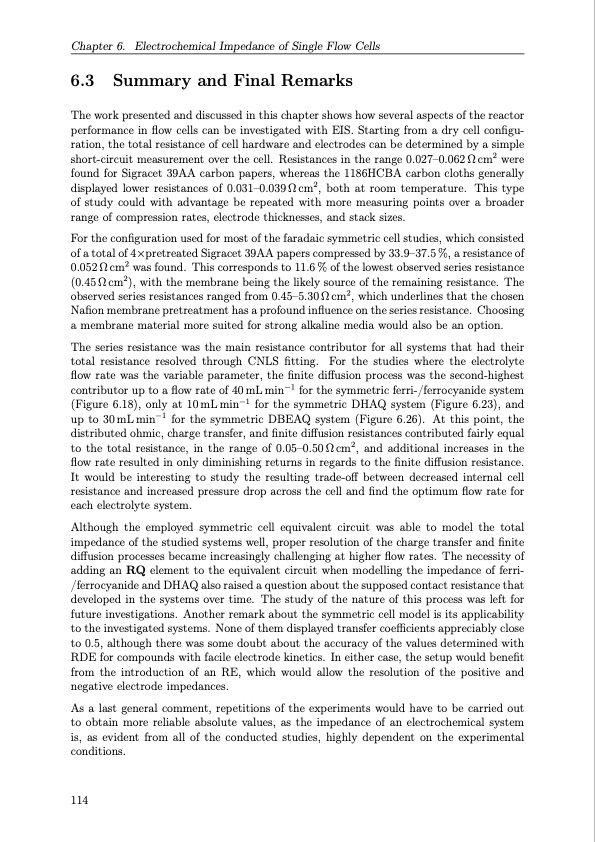
PDF Publication Title:
Text from PDF Page: 135
Chapter 6. Electrochemical Impedance of Single Flow Cells 6.3 Summary and Final Remarks The work presented and discussed in this chapter shows how several aspects of the reactor performance in flow cells can be investigated with EIS. Starting from a dry cell configu- ration, the total resistance of cell hardware and electrodes can be determined by a simple short-circuit measurement over the cell. Resistances in the range 0.027–0.062 Ω cm2 were found for Sigracet 39AA carbon papers, whereas the 1186HCBA carbon cloths generally displayed lower resistances of 0.031–0.039Ωcm2, both at room temperature. This type of study could with advantage be repeated with more measuring points over a broader range of compression rates, electrode thicknesses, and stack sizes. For the configuration used for most of the faradaic symmetric cell studies, which consisted of a total of 4×pretreated Sigracet 39AA papers compressed by 33.9–37.5 %, a resistance of 0.052 Ω cm2 was found. This corresponds to 11.6 % of the lowest observed series resistance (0.45 Ω cm2), with the membrane being the likely source of the remaining resistance. The observed series resistances ranged from 0.45–5.30 Ω cm2, which underlines that the chosen Nafion membrane pretreatment has a profound influence on the series resistance. Choosing a membrane material more suited for strong alkaline media would also be an option. The series resistance was the main resistance contributor for all systems that had their total resistance resolved through CNLS fitting. For the studies where the electrolyte flow rate was the variable parameter, the finite diffusion process was the second-highest contributor up to a flow rate of 40 mL min−1 for the symmetric ferri-/ferrocyanide system (Figure 6.18), only at 10 mL min−1 for the symmetric DHAQ system (Figure 6.23), and up to 30mLmin−1 for the symmetric DBEAQ system (Figure 6.26). At this point, the distributed ohmic, charge transfer, and finite diffusion resistances contributed fairly equal to the total resistance, in the range of 0.05–0.50Ωcm2, and additional increases in the flow rate resulted in only diminishing returns in regards to the finite diffusion resistance. It would be interesting to study the resulting trade-off between decreased internal cell resistance and increased pressure drop across the cell and find the optimum flow rate for each electrolyte system. Although the employed symmetric cell equivalent circuit was able to model the total impedance of the studied systems well, proper resolution of the charge transfer and finite diffusion processes became increasingly challenging at higher flow rates. The necessity of adding an RQ element to the equivalent circuit when modelling the impedance of ferri- /ferrocyanide and DHAQ also raised a question about the supposed contact resistance that developed in the systems over time. The study of the nature of this process was left for future investigations. Another remark about the symmetric cell model is its applicability to the investigated systems. None of them displayed transfer coefficients appreciably close to 0.5, although there was some doubt about the accuracy of the values determined with RDE for compounds with facile electrode kinetics. In either case, the setup would benefit from the introduction of an RE, which would allow the resolution of the positive and negative electrode impedances. As a last general comment, repetitions of the experiments would have to be carried out to obtain more reliable absolute values, as the impedance of an electrochemical system is, as evident from all of the conducted studies, highly dependent on the experimental conditions. 114PDF Image | Organic Redox Flow Batteries 2023

PDF Search Title:
Organic Redox Flow Batteries 2023Original File Name Searched:
PhD_thesis_final_dorhoff_4_.pdfDIY PDF Search: Google It | Yahoo | Bing
Salgenx Redox Flow Battery Technology: Salt water flow battery technology with low cost and great energy density that can be used for power storage and thermal storage. Let us de-risk your production using our license. Our aqueous flow battery is less cost than Tesla Megapack and available faster. Redox flow battery. No membrane needed like with Vanadium, or Bromine. Salgenx flow battery
| CONTACT TEL: 608-238-6001 Email: greg@salgenx.com | RSS | AMP |